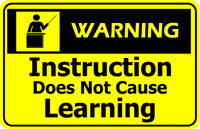A couple of mornings ago I found myself sitting near the front of a very large room, packed in shoulder-to-shoulder with several hundred other folks. We all wanted to learn the secrets  of success that were stored away in the carefully moussed head of an amazingly handsome and talented young man who knew way more than we did. I had looked forward to the opportunity to improve my skills, to understand how he had succeeded when so many others had failed, and to leave that morning with lots of ideas on how to make things happen.
of success that were stored away in the carefully moussed head of an amazingly handsome and talented young man who knew way more than we did. I had looked forward to the opportunity to improve my skills, to understand how he had succeeded when so many others had failed, and to leave that morning with lots of ideas on how to make things happen.
One hour later, I walked out half asleep, desperate for coffee and fresh air. One day later, I’m not sure that I could have told you one single main point of his presentation. What happened?
He made a speech, and those don’t work anymore. It was very nicely done — the PowerPoint slides were attractive, the images appropriate, and he had his subject down cold. But within a few minutes, my attention began to wander. I checked my email, started dissecting his presentation design, looked around at the other attendees, looked at my watch — there just wasn’t enough there to hold my attention.
We live in a world where we expect to be engaged – commenting, writing, replying, sharing — and the one-to-many model of a lecture is no longer effective for educating a group about your topic.
So what do you do, if you’d actually like to make your ideas stick after the applause ends and the projector cools off? Here are a few ideas:
- Check For Understanding Ask members of the audience to give examples of situations where your idea could be used or implemented — this requires us to pay attention, and lets you know if we got the point
- Get Our Input Have “blank” PowerPoint slides where we call out ideas to put on the list, and you add them. The five most important things about… The worst ways to do…
- Talk To Us First Before your lecture, talk to the audience — then during your talk, use that information. “John over there — in his hospital, he has this problem. Tell us about it…”
- Tell Us Stories Storytelling is the most effective way of communicating — that’s why there are drawings in caves. Don’t just say what to do — give us the context.
- Do The Q & A First, Not Last Before you start talking, ask us what we want to hear — and list our questions on a flip chart. Keep referencing back to that during your talk — you’ll be a hero, and you can tailor what you say to just what we need.
- Sum It Up For Us Have a summation or “take-aways” slide ready — and use it. Leave it up there at the end when you’re done.
- Don’t Complain No matter how much time you get, even if it’s half what you were promised, don’t complain. Make it work. Have a plan for 75%, 50%, 25% of what you were promised and be ready to do it.
And my personal favorite “must do”? Give us a link! Provide us a simple link to get more information on your web or blog that contains links to everything you mention in your lecture. Don’t make us work for it. This also lets us share out your wisdom with all our little friends.
If you accomplish just part of this you’re well on the road to being an amazing speaker.

{ 2 comments… read them below or add one }
How about value to the audience? Everybody in the audience? If the speaker was presenting on “time management” did you leave with some specific actions you could put to use today or tomorrow, or at least research and test?
When it comes to giving that link, a presenter can demonstrate a lot about the value of web 2.0 by saying, “You don’t have to write down any of my references. You’ll find them all at http://www.delicious.com/talkguy/this_tag .”
Outside early adopters, relatively few people have used delicious. Saving a bunch of worthwhile links, and adding a tag for this specific event, can fling open a door in a way that 15 minutes of yammering about social bookmarks will not.